 |
Home | Charity | Feedback |
India: Uttar Pradesh:
Agra,
Mirzapur,
Prayagraj,
Varanasi
Varanasi, India: The final truth by Prakash Bang, Editor in Chief 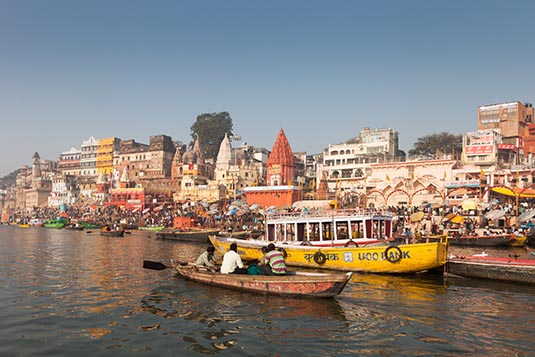 It is holiest of the seven sacred cities in Hinduism and Jainism. Hindus believe that death at Varanasi brings salvation. Varanasi, erstwhile Kashi and Banaras (also spelt as Beneras), is one of the oldest continuously inhabited cities in the world and indeed the oldest in India. People often refer to Varanasi as "the city of temples", "the holy city of India", "the religious capital of India", "the city of lights", "the city of learning", and of course "the oldest living city on earth". 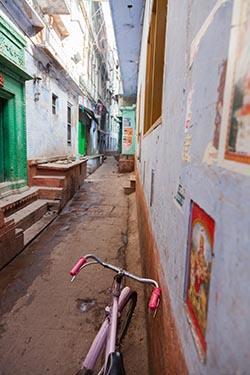 Because I was planning a trip to Allahabad to witness the Kumbh Mela (fair), it was only prudent that I club my trip with a visit to Varanasi. Allahabad and Varanasi are 120 kms apart and fall on the Grand Trunk Road. Varanasi is very well connected by air, rail and road. I reached Varanasi International airport at 10:30AM from Mumbai.
Because I was planning a trip to Allahabad to witness the Kumbh Mela (fair), it was only prudent that I club my trip with a visit to Varanasi. Allahabad and Varanasi are 120 kms apart and fall on the Grand Trunk Road. Varanasi is very well connected by air, rail and road. I reached Varanasi International airport at 10:30AM from Mumbai.
Generally flights to Varanasi are pretty much full. Thanks to the religious sentiments attached with the town. Apart from believers of Hindu and Jain faiths, Varanasi attracts thousands of Buddhist followers. Then of course there are travelers from all around the world who come to Varanasi to see the play of life and death on the banks of the River Ganga (Ganges) – the holiest of the rivers of India. I was fortunate to have my close family friend Krishnakumar Kabra to accompany me for the two days that I was to be there. Krishnakumar has spent most of his life in Varanasi and therefore knew the finer nuances of the city not to forget the tiny lanes (thoroughfare for the locals). I couldn’t have asked for a better guide! We had a car at our disposal. 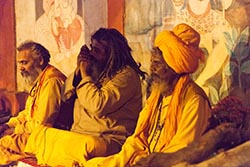 Directly from the airport we headed for Sarnath, just on the outskirts of Varanasi. At Sarnath Lord Buddha gave his first sermon. Lord Buddha went from Bodhgaya to Sarnath about 5 weeks after his enlightenment. Before Gautama (the Buddha-to-be) attained enlightenment, he gave up his austere penances. His friends, the Pancavaggiya monks, left him and went to Isipatana (also known as Sarnath).
Directly from the airport we headed for Sarnath, just on the outskirts of Varanasi. At Sarnath Lord Buddha gave his first sermon. Lord Buddha went from Bodhgaya to Sarnath about 5 weeks after his enlightenment. Before Gautama (the Buddha-to-be) attained enlightenment, he gave up his austere penances. His friends, the Pancavaggiya monks, left him and went to Isipatana (also known as Sarnath).
After attaining enlightenment Buddha left Uruvela and travelled to Isipatana to join and teach his friends. He went to them because, using his spiritual powers, he had seen that his five former companions would be able to understand Dharma quickly. When Gautama Buddha found his five former companions, he taught them, they understood and as a result they also became enlightened. At that time the Sangha, the community of the enlightened ones, was founded. The sermon Buddha gave to the five monks was his first sermon, called the Dhammacakkappavattana Sutta. 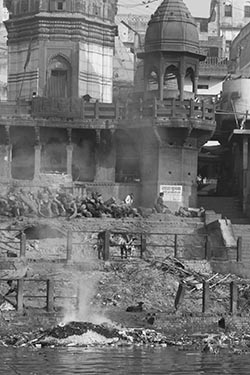 Sarnath has been developed as a place of pilgrimage, both for Buddhists from India and abroad. A number of countries in which Buddhism is a major (or the dominant) religion, among them Thailand, Japan, China, Sri Lanka and Myanmar, have established temples and monasteries in Sarnath in the style that is typical for the respective country. Thus, pilgrims and visitors have the opportunity to experience an overview of Buddhist architecture from various cultures.
Sarnath has been developed as a place of pilgrimage, both for Buddhists from India and abroad. A number of countries in which Buddhism is a major (or the dominant) religion, among them Thailand, Japan, China, Sri Lanka and Myanmar, have established temples and monasteries in Sarnath in the style that is typical for the respective country. Thus, pilgrims and visitors have the opportunity to experience an overview of Buddhist architecture from various cultures.
Few highlights at Sarnath include: The Dhamek Stupa is 128 feet high and 93 feet in diameter. The Dharmarajika Stupa is one of the few pre-Ashokan stupas remaining, although only the foundations remain. The rest of the Dharmarajika Stupa was removed to Varanasi to be used as building materials in the 18h century. At that time, relics were also found in the Dharmarajika Stupa. These relics were subsequently thrown in the Ganges river. The Chaukhandi Stupa commemorates the spot where the Buddha met his first disciples, dating back to the fifth century. The ruins of the Mulagandhakuti vihara mark the place where the Buddha spent his first rainy season. The Ashoka Pillar erected here, originally surmounted by the "Lion Capital of Asoka" (presently on display at the Sarnath Museum), and was broken during Turk invasions but the base still stands at the original location. The Sarnath Archeological Museum houses the famous Ashokan lion capital, which miraculously survived its 45-foot drop to the ground (from the top of the Ashokan Pillar), and became the National Emblem of India and national symbol on the Indian flag. There is also a Bodhi tree planted by Anagarika Dharmapala which was grown from a cutting of the Bodhi Tree at Bodh Gaya. 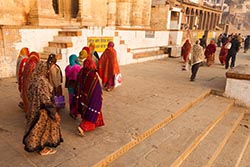 After spending couple of hours in Sarnath, we drove on the outskirts to visit Aadi Keshav Mandir (one of the hundreds in Varanasi) with stands at the confluence of River Varuna with Ganges. Our next stop was Bharat Mata Mandir.
After spending couple of hours in Sarnath, we drove on the outskirts to visit Aadi Keshav Mandir (one of the hundreds in Varanasi) with stands at the confluence of River Varuna with Ganges. Our next stop was Bharat Mata Mandir.
The Bharat Mata temple at Varanasi is the only temple dedicated to Mother India. It is located in the Mahatma Gandhi Kashi Vidyapeeth campus. The Bharat Mata temple was built by Babu Shiv Prasad Gupt and inaugurated by Mahatma Gandhi in 1936. The statute of Bharat Mata is built in marble and is a model of undivided India, depicting the mountains, plains and oceans. The most peculiar thing about the Bharat Mata Temple is that instead of the customary gods and goddesses, it houses a relief map of India, carved to scale, out of marble. 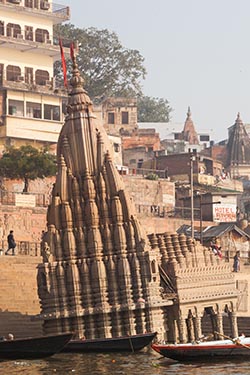 After paying our respects to the motherland, we moved towards the sprawling campus of BHU – Beneras Hindu University, a famous icon of Varanasi. Established in 1916 by Pandit Madan Mohan Malviya, Banaras Hindu University, more popularly known as BHU is one of the largest residential universities in Asia, with over 20,000 students. The university's main campus spread is over 1,300 acres and was built on land donated by the Kashi Naresh, the hereditary ruler of Banaras. BHU is organised into 4 institutes and 14 faculties and more than 140 departments. Several of its colleges, including engineering (IIT-BHU), science, linguistics, journalism & mass communication, performing arts, law, agriculture (IAS-BHU), medicine (IMS-BHU) and management (FMS), are ranked among the best in India. When in Varanasi, probably the only activity is visiting as many temples as possible! The BHU campus had one too.
After paying our respects to the motherland, we moved towards the sprawling campus of BHU – Beneras Hindu University, a famous icon of Varanasi. Established in 1916 by Pandit Madan Mohan Malviya, Banaras Hindu University, more popularly known as BHU is one of the largest residential universities in Asia, with over 20,000 students. The university's main campus spread is over 1,300 acres and was built on land donated by the Kashi Naresh, the hereditary ruler of Banaras. BHU is organised into 4 institutes and 14 faculties and more than 140 departments. Several of its colleges, including engineering (IIT-BHU), science, linguistics, journalism & mass communication, performing arts, law, agriculture (IAS-BHU), medicine (IMS-BHU) and management (FMS), are ranked among the best in India. When in Varanasi, probably the only activity is visiting as many temples as possible! The BHU campus had one too.
We next visited the Sankat Mochan Hanuman temple (monkey headed God), one of the oldest ones in Varanasi. It is believed that temple has been built on the very spot where Tulsidas, an ardent devotee of Lord Rama, had a vision of Hanuman. Sankat Mochan Temple was founded by Tulsidas who was the author of the Ramacharitamanasa, which is the Hindi version of the Hindu epic Ramayana originally written by Valmiki. Tradition promises that regular visitors to the temple will gain special favor of Hanuman. Every Tuesday and Saturday thousands of people queue up in front of temple to offer prayers to Lord Hanuman. According to Vedic Astrology, Hanuman saves human beings from the anger of the planet Shani (Saturn), and people having an ill-placed Saturn in their horoscopes especially visit this temple for astrological remedies. 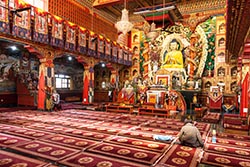 It was almost 5PM. Since we were on the road ever since I landed, a little rest was much deserved. I was hosted at Krishnakumar’s residence in Ravindrapura one of Varanasi’s upmarket residential colonies. Some snacks and a hot cup of tea, energized me to explore the evening ahead.
It was almost 5PM. Since we were on the road ever since I landed, a little rest was much deserved. I was hosted at Krishnakumar’s residence in Ravindrapura one of Varanasi’s upmarket residential colonies. Some snacks and a hot cup of tea, energized me to explore the evening ahead.
We drove the car as much as possible towards Dasashwamedh Ghat. When we couldn’t inch forward, we asked the driver to park nearby. The next couple of hours we would explore by foot. In fact, that’s the fastest way to get around old city. 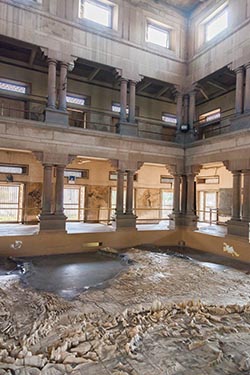 At 7PM every evening prayers are offered on the banks of River Ganges. These prayers are known as Ganga Aarti. They happen simultaneously at Dasashwamedh Ghat and Prayag Ghat which are adjacent to each other. Attending the Aarti is one must ritual to visit. Thousands of pilgrims and tourists throng the ghats… reaching their by foot or by boats.
At 7PM every evening prayers are offered on the banks of River Ganges. These prayers are known as Ganga Aarti. They happen simultaneously at Dasashwamedh Ghat and Prayag Ghat which are adjacent to each other. Attending the Aarti is one must ritual to visit. Thousands of pilgrims and tourists throng the ghats… reaching their by foot or by boats.
After spending some time on the banks, we moved towards Dedhsipul and Vishwanath Lane. I wanted to try my luck of visiting the famous Kashi Vishwanath Temple. Miles long queues awaited us. Disheartened we decided to turn back. As luck would have it, one of Krishnakumar’s friends showed us a shortcut to the sanctum sanctorum. I had to plead with the guards to let me in. He reluctantly allowed me in. In the Kashi Vishwanath Temple is enshrined the Jyotirlinga of Shiva, Vishweshwara or Vishwanatha. Here gravitate millions of folks to seek benediction and spiritual peace by the darshan of this Jyotirlinga which confers liberation from the bondages of maya and the inexorable entanglements of the world. Vishweshwara Jyotirlinga has a very special and unique significance in the spiritual history of India. Tradition has it that the merits earned by the darshan of other jyotirlinga scattered in various parts of India accrue to devotee by a single visit to Kashi Vishwanath Temple. Deeply and intimately implanted in the Hindu mind, the Kashi Vishwanath Temple has been a living embodiment of timeless cultural traditions and highest spiritual values. 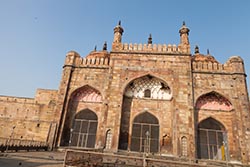 When in Varanasi, they say do as the Varanasians do. Eat, drink and make merry. Every lane in Varanasi will have vendors of sorts. Sweets and savouries, made using desi ghee (reduced butter) are everyone’s favourite. Post snacks and meals it is only customary that one enjoys thandai (milk based drink loaded with dried fruit) laced with bhang (crushed poppy seeds) and of course the banarsi paan (beetle leaf). I did all that. The calories and the guilt that came with it only ensured that I slept well through the night.
When in Varanasi, they say do as the Varanasians do. Eat, drink and make merry. Every lane in Varanasi will have vendors of sorts. Sweets and savouries, made using desi ghee (reduced butter) are everyone’s favourite. Post snacks and meals it is only customary that one enjoys thandai (milk based drink loaded with dried fruit) laced with bhang (crushed poppy seeds) and of course the banarsi paan (beetle leaf). I did all that. The calories and the guilt that came with it only ensured that I slept well through the night.
If Varanasi is all about temples it’s also all about ghats – embankments (generally made of stones and granite) along the river. There are well over 100 ghats in Varanasi. Ghats are the locations were pilgrims can perform their rituals – from performing pujas, offering prayers, bathing to cleanse sins and finally to cremate the dead. Countless ghats are built all along the Ganges in Varanasi. The ghats have been built over the years either by the locals or by royalties from around the country. 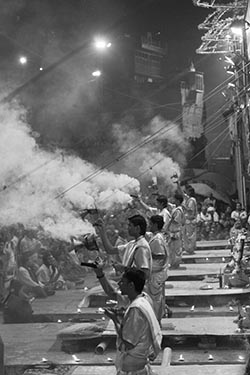 At 6AM the next morning we decided to commence our ‘ghat exploration’. It all started by witnessing the sunrise at Assi Ghat. Adjoining were Ganga Mahal Ghat, Rewa Ghat and Tulsi Ghat. It’s believed that the name Varanasi has been coined by Varanasi’s two rivers Varuna and Assi (the tributaries of Ganges). While River Varuna can be seen, River Assi has now reduced to becoming a small nullah.
At 6AM the next morning we decided to commence our ‘ghat exploration’. It all started by witnessing the sunrise at Assi Ghat. Adjoining were Ganga Mahal Ghat, Rewa Ghat and Tulsi Ghat. It’s believed that the name Varanasi has been coined by Varanasi’s two rivers Varuna and Assi (the tributaries of Ganges). While River Varuna can be seen, River Assi has now reduced to becoming a small nullah.
From a photographer’s perspective, it’s a good idea to hire a boat from Assi Ghat and row down-stream all the way up to Panch Ganga Ghat. By flowing with the water, it’s easy for the oarsman and also helps the boat to glide almost without jerks. The ride lasts for about 90 minutes. It’s better to negotiate beforehand. Around Rs 300 (depending upon the season) should do the trick. Here are the ghats we negotiated: Bhadini Ghat; Janaki Ghat; Chetsingh Ghat; Harischandra Ghat; Kedar Ghat; Raja Ghat; Chausatti Ghat; Dashashwamedh Ghat; Manmandir Ghat; Tripur Bhairavi Ghat; Meer Ghat; Lalita Ghat; Manikarnika Ghat; Scindia Ghat; Mangla Gauri Ghat and the Panch Ganga Ghat. 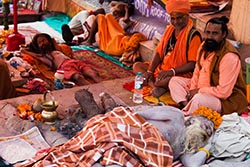 Assi Ghat is where the Ganges River meets the River Assi. It's located at the extreme southern end of the main ghats, and hence it's not as crowded and chaotic as some of the other ghats. However, it is an important ghat for Hindus. Pilgrims bathe here before worshiping Lord Shiva, in the form of huge lingam under a nearby pipal tree.
Assi Ghat is where the Ganges River meets the River Assi. It's located at the extreme southern end of the main ghats, and hence it's not as crowded and chaotic as some of the other ghats. However, it is an important ghat for Hindus. Pilgrims bathe here before worshiping Lord Shiva, in the form of huge lingam under a nearby pipal tree.
Chet Singh Ghat has quite a bit of historical importance as it was the site of the 18th century battle between Maharaja Chet Singh and the British. Here's an old fort which marks the spot of Chet Singh's defeat. 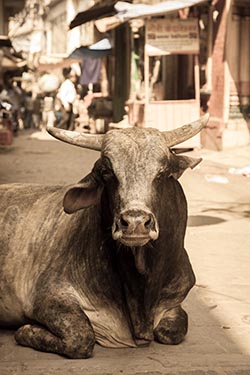 Dasashwamedh Ghat is the heart of the action and the top attraction in Varanasi. One of the oldest and holiest Varanasi ghats, it's where the famous Ganga aarti takes place every evening.
Dasashwamedh Ghat is the heart of the action and the top attraction in Varanasi. One of the oldest and holiest Varanasi ghats, it's where the famous Ganga aarti takes place every evening.
Man Mandir Ghat is worth checking out for its exquisite Rajput architecture. Rajput Maharajah Man Singh of Jaipur built his palace here in 1600. An additional attraction, the observatory, was added in the 1730s by Sawai Jai Singh II. The astronomical instruments are still in good condition and it's possible to take a look at them. Manaikarnika Ghat is the most confronting of all ghats. Simply put it is also known as the burning ghat. It is the place where the majority of dead bodies are cremated in Varanasi. Other burning ghat is Harischandra Ghat. Hindus believe it will liberate them from the cycle of death and rebirth. Indeed, you'll openly come face to face with death at Manikarnika Ghat. Piles of firewood line the shore and the fires continually burn with the stream of dead bodies, each wrapped in cloth and carried through the lanes on makeshift stretchers by the doms (a caste of untouchables that handles the corpses and supervises the cremation. 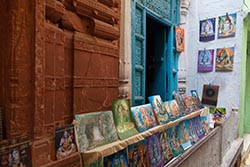 Scindhia Ghat adjoins Manikarnika Ghat on the northern side. It's quite a picturesque place that has none of the grimness of its neighboring ghat. Of particular interest is the partially submerged Shiva Temple at the water's edge. It sunk during the construction of the ghat in 1830. The narrow maze of alleyways above the ghat hides a number of Varanasi's important temples. This area is called Sidha Kshetra and it attracts plenty of pilgrims.
Scindhia Ghat adjoins Manikarnika Ghat on the northern side. It's quite a picturesque place that has none of the grimness of its neighboring ghat. Of particular interest is the partially submerged Shiva Temple at the water's edge. It sunk during the construction of the ghat in 1830. The narrow maze of alleyways above the ghat hides a number of Varanasi's important temples. This area is called Sidha Kshetra and it attracts plenty of pilgrims.
Lalita Ghat was built the late King of Nepal. It is the site of the Ganges Keshav Temple, a wooden temple built in typical Kathmandu style. The temple has an image of Pashupateshwar, a manifestation of Lord Shiva. 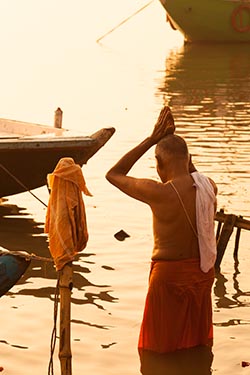 We alighted at Panchganga Ghat. From now on, we would do our return journey, almost parallel to the Ganges but on foot and by negotiating extremely narrow lanes. The lanes of Varanasi are bound to astonish one and all. I wonder how people built dwellings that are 5 storyes high on each side of the lane – a lane that’s barely 5 feet wide; even less! And these lanes are thoroughfares for the residents. One has to be careful to avoid accidents with fellow walkers, motorcyles, cows and cow dung. And adding to the glory are vendors of sorts… food, milk, pan, flowers, thandai, photo frames and what have you.
We alighted at Panchganga Ghat. From now on, we would do our return journey, almost parallel to the Ganges but on foot and by negotiating extremely narrow lanes. The lanes of Varanasi are bound to astonish one and all. I wonder how people built dwellings that are 5 storyes high on each side of the lane – a lane that’s barely 5 feet wide; even less! And these lanes are thoroughfares for the residents. One has to be careful to avoid accidents with fellow walkers, motorcyles, cows and cow dung. And adding to the glory are vendors of sorts… food, milk, pan, flowers, thandai, photo frames and what have you.
After climbing about hundred steps from Panchganga Ghat we reached the Alamgir Mosque. Alamgir Mosque, also known as Beni Madhav Ka Darera, was constructed by the Mughal Emperor, Aurangazeb. It is believed that there was once a temple of Lord Krishna at the site where Alamgir Mosque is situated. Being the largest structure located on the banks of river Ganges, the mosque was constructed during the invasions of Mughals in India. Possessing an imposing construction, the architecture of this structure features a blend of Hindu and Persian styles. Standing on the carved pillars, turrets and beautiful domes, the mosque is frequented by devotees and tourists while visiting the Panchganga Ghat. The lower part of the mosque has a Hindu temple and the design of the whole structure presents rich artworks of ancient India. 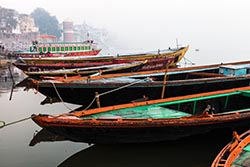 From the Darera we negotiated our way through many lanes, namely: Dudh Vinayak Lane (there’s a vendor that churns out delicious jalebis (sweet) and kachoris (savoury)); Chaukhambha Lane (the location for Gopal Temple); Thateri Bazaar (a commercial street); Chowk and finally Gyan Vapi. From here we boarded a cycle rickshaw to take us home. Lunch was very much due. It had been over 8 hours since we left home.
From the Darera we negotiated our way through many lanes, namely: Dudh Vinayak Lane (there’s a vendor that churns out delicious jalebis (sweet) and kachoris (savoury)); Chaukhambha Lane (the location for Gopal Temple); Thateri Bazaar (a commercial street); Chowk and finally Gyan Vapi. From here we boarded a cycle rickshaw to take us home. Lunch was very much due. It had been over 8 hours since we left home.
After a quick, but delicious lunch (Krishnakumar’s wife is a great cook!) we left for an afternoon stroll through more of the Varanasi lanes, squares and mohallas (small colonies), namely: Bans Phatak; Bada Dev; Gadaulia; Jangamwadi; Madan Pura; Sonar Pura; Shivala; Mansarovar; Devnath; August Kunda; Dasashwamedh; Manmandir; Tripur Bharavi; Dedhmal Lane and Lahori Tola. By 5PM we were back. It was now time for me to bid farewell and proceed to Mirzapur for my night halt. Varanasi Image Gallery  Photo viewer Photo viewer
|
|
|
Home |
Charity |
Feedback
Privacy Policy | Terms of Usage © YoGoYo.com. All rights reserved. |





































































































